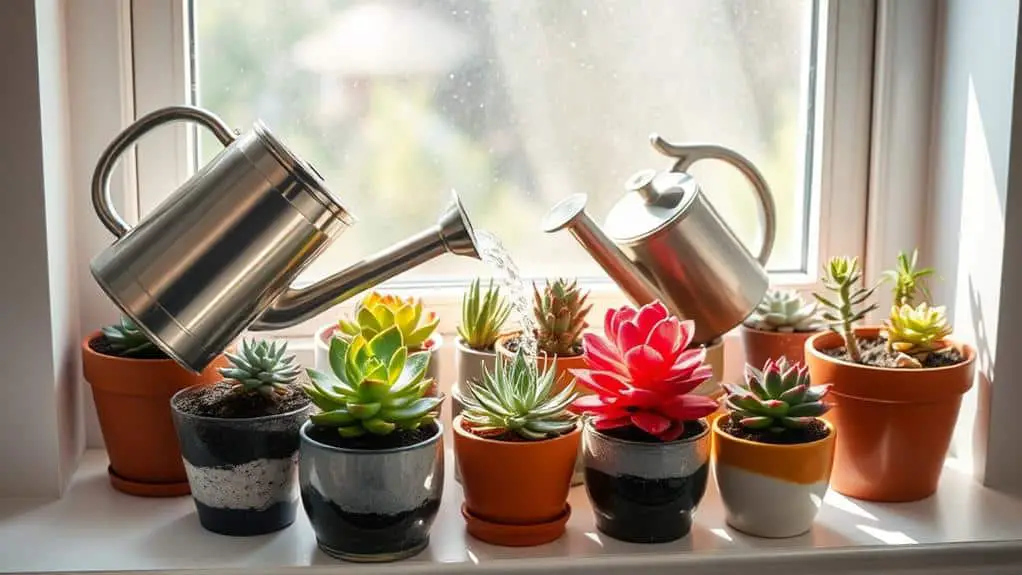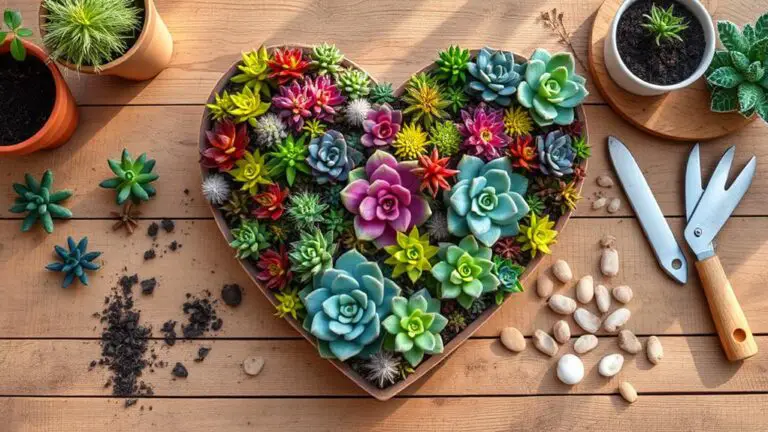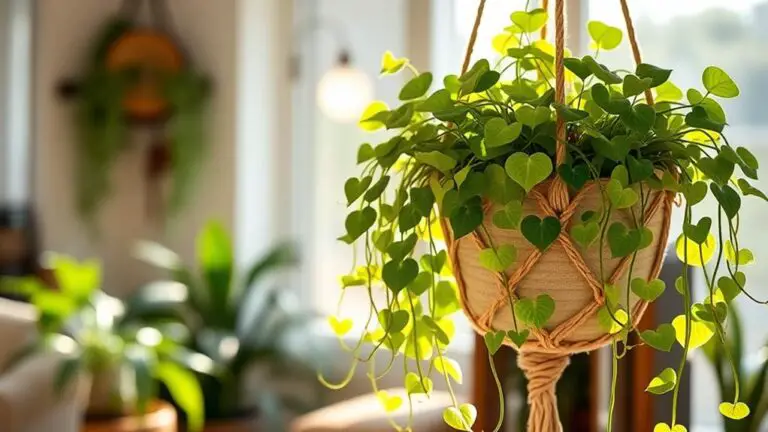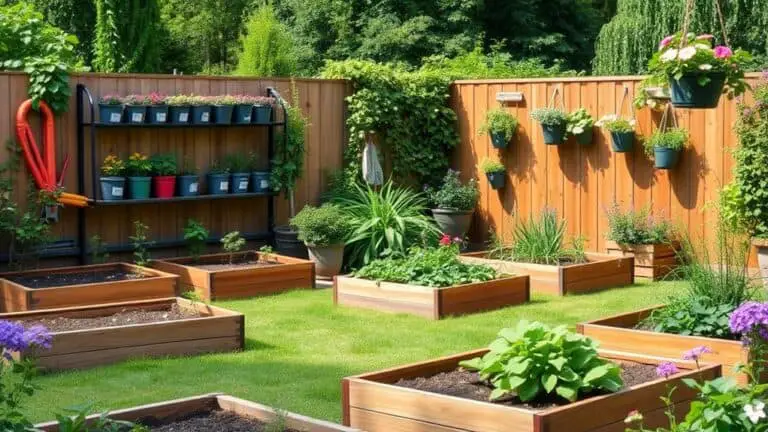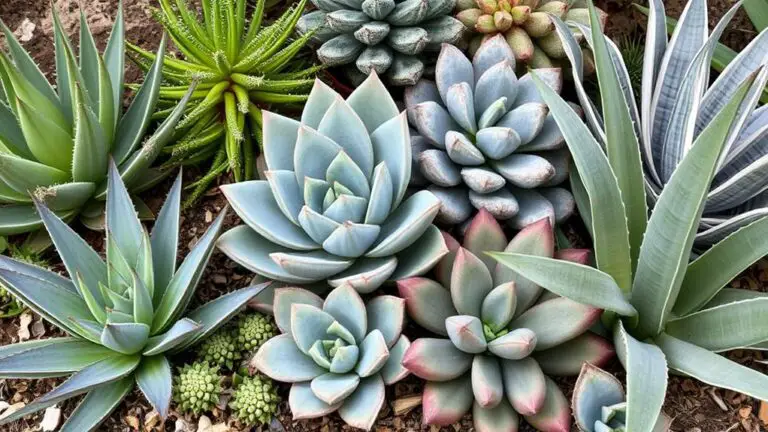7 Essential Tips for Watering Thriving Succulents
Taking care of succulents can be tricky if you don't know the right watering techniques. You might think they don't need much attention, but getting the watering just right is vital for their health. We'll cover seven essential tips to help you master the art of succulent care, starting with understanding when to water. From there, we'll tackle the best watering methods, soil choices, and more. Ready to see your succulents flourish? Let's get into the details that can make all the difference.
Know When to Water
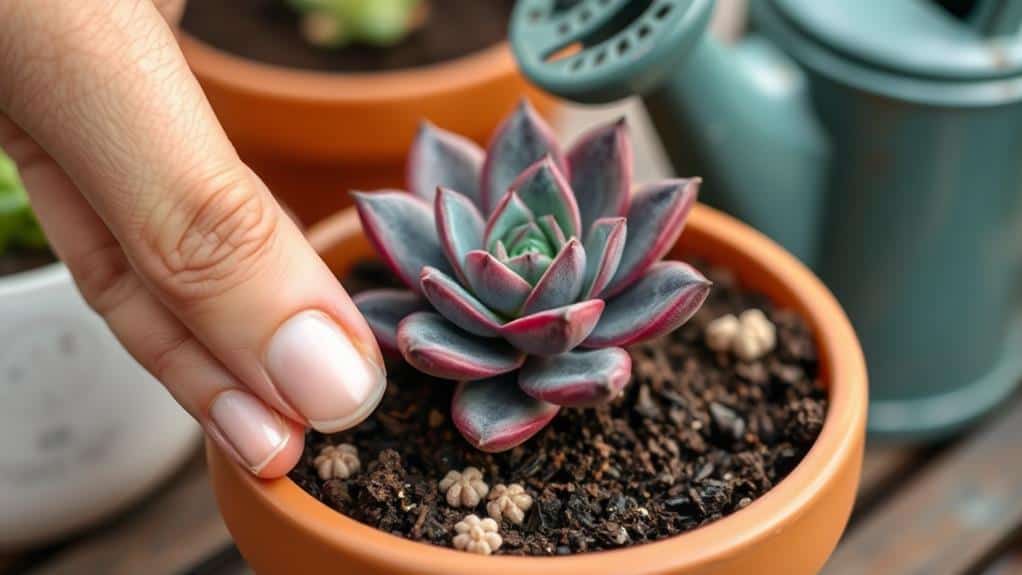
Knowing when to water your succulents is essential to their health and longevity. To water your succulents properly, you need to check if the top half-inch of soil is dry. This guarantees you don't overwater and harm their root system.
The frequency of watering depends on whether your succulents are indoors or outdoors. Indoor succulents usually need water every 2-4 weeks, while outdoor ones might need it every 1-2 weeks during their growing season.
Pay attention to environmental conditions like temperature and humidity; these factors affect how fast the soil dries out. If you notice limp leaves and extremely dry soil, these are signs of underwatering. Conversely, yellowing leaves and mushy stems indicate overwatering, which means you should adjust your watering habits immediately.
During dormancy in colder months, reduce the frequency of watering to every 4-6 weeks, as succulents grow slower and need less water then.
Always use well-drained soil to avoid waterlogging. By observing these guidelines, you'll guarantee your succulents thrive, keeping them healthy and vibrant in any season.
Use Proper Watering Techniques
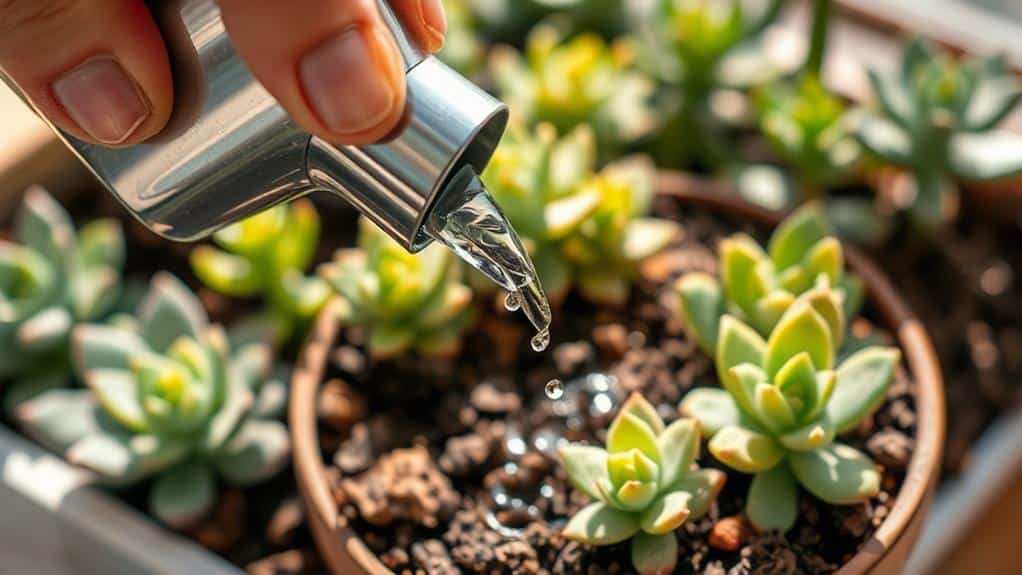
To guarantee your succulents are getting the right amount of water, using proper watering techniques is just as important as knowing when to water. Start with the Soak and Dry Method. Thoroughly water your succulents until water drains from the pot's holes. This guarantees deep watering, mimicking natural rain, and provides long-term moisture access.
It's vital to let the soil dry completely before re-watering. This helps prevent root rot and encourages deep root growth, which is essential for your succulents to thrive.
Always check the soil moisture before watering again. Make sure the top half-inch of soil is dry. Overwatering is a common mistake that can harm your succulents. Instead of misting, focus on soaking the soil while keeping the leaves dry. Misting can lead to rot and other issues.
To keep track of your watering routine, note the dates and soil moisture levels. This helps you adapt to seasonal changes in temperature and light. Consistency is key.
Choose the Right Soil

When choosing soil for your succulents, proper drainage is key.
Use a mix of soil, sand, peat moss, and perlite to prevent water from sitting too long and causing root rot.
Avoid heavy, compact soils that can suffocate the roots and lead to problems.
Ensure Proper Drainage
One key aspect to keeping your succulents healthy is guaranteeing proper drainage by choosing the right soil. When you're watering succulents, they need soil that drains well to thrive. A mix of equal parts soil, sand, peat moss, and perlite works wonders. It helps prevent waterlogging and promotes healthy root growth.
Avoid using heavy clay or compact soil, as these can suffocate the roots. This leads to increased moisture, bacterial growth, and root rot. Make sure your pot has adequate drainage holes. This allows excess water to escape, preventing standing water that can harm your succulents.
Here's a quick breakdown:
| Key Component | Benefit |
|---|---|
| Soil | Provides nutrients |
| Sand | Enhances drainage |
| Peat Moss | Retains just enough moisture |
| Perlite | Increases aeration |
Also, consider adding gritty materials like Jack's Gritty Mix to improve drainage further. This guarantees your succulent roots get the aeration they need. Regularly check the soil's moisture levels. Only water when it's dry to maintain the right moisture balance for your succulents.
Avoid Heavy Soil
Succulents thrive best in well-draining soil, and avoiding heavy soil is crucial for their health. You want your succulents to stay happy and healthy, which means giving them the right environment. Heavy clay or compact soil retains too much moisture, which can lead to root rot.
Root rot happens when the roots sit in water for too long, causing them to decay and harm your plant. Instead, use a well-draining soil mix. A good recipe includes equal parts soil, sand, peat moss, and perlite. This mix allows water to flow through easily, preventing moisture from lingering around the roots.
A gritty mix, like Jack's Gritty Mix, is also a fantastic option for improving drainage and supporting robust root systems. Don't forget about your pot's drainage. Always choose pots with drainage holes so excess water can escape.
This helps keep your watering schedule on track and guarantees your succulents don't get waterlogged. By using the right soil and guaranteeing proper drainage, you'll help your succulents thrive and avoid common problems like root rot.
Optimize Pot Selection
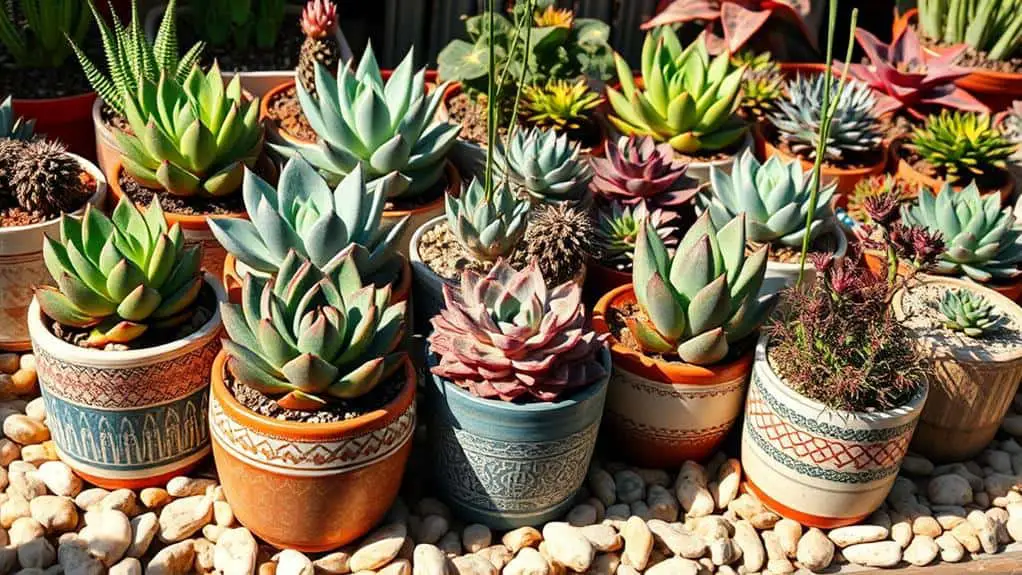
When choosing a pot for your succulents, make sure it has drainage holes to let excess water escape and prevent root rot.
Clay pots are a great option because they dry out faster and help air reach the roots better than plastic ones.
Also, pick a pot that fits your succulent snugly to avoid too much moisture lingering and causing bacterial problems.
Choose Appropriate Size
Ever wondered why your succulents aren't thriving despite your best efforts? Choosing the appropriate size pot is essential for their health.
Succulents need snug spaces to prevent overwatering and promote healthier growth. Over-potting can lead to excess moisture retention, which increases the risk of waterlogged soil and root rot.
Here's how to optimize your pot selection:
- Select Clay Pots: These dry out faster and provide better air circulation to the roots compared to plastic pots.
- Avoid Large Pots: Larger pots retain moisture longer, which can make managing watering schedules tricky.
- Mix Your Soil: Use a mix of perlite and sterilized soil to enhance drainage and promote root health.
- Consider Plant Size: Make sure your pot is only slightly larger than the plant itself to prevent overwatering.
Prioritize Drainage Holes
Without proper drainage, even the best potting techniques won't save your succulents. Drainage holes are vital for avoiding water-logged soil, which can lead to root rot. You should always prioritize pots with adequate drainage to guarantee healthy growth for your succulents.
Clay pots are a great choice because they dry out faster and provide better air circulation compared to plastic pots. This helps in reducing excess moisture, which is fundamental to preventing root rot. Avoid over-potting, as larger containers retain moisture longer, increasing the risk of bacterial infections.
When selecting a pot, it's important to choose one that snugly fits your succulent. This helps in avoiding excess moisture retention, promoting healthier growth. Here's a quick guide to help you understand the importance of drainage holes:
| Feature | Benefit |
|---|---|
| Drainage Holes | Prevents water-logged soil |
| Clay Pots | Better air circulation and drying |
| Snug Fit | Reduces excess moisture retention |
| Adequate Drainage | Promotes healthy root growth |
Select Pot Material
Selecting the right pot material is essential for the health of your succulents. Different pots have unique benefits and choosing the best one can make a big difference for your plants. Here's a quick guide to help you decide:
- Clay Pots: These are great for succulents because they dry out quickly and allow air to circulate around the roots. This helps keep the soil from staying too wet and prevents root rot.
- Plastic Pots: While they keep moisture longer, plastic pots can promote faster growth due to varying root temperatures. They might be better for certain succulent species that have higher water needs.
- Avoid Over-Potting: Choose pots that fit your succulents snugly. Larger pots can hold too much moisture, which increases the risk of bacterial infections.
- Drainage Holes: Always pick pots with drainage holes. They let excess water escape, which is vital to avoid standing water that can harm your plants.
Using porous materials or adding perlite to your potting mix can also enhance drainage and support healthy root systems.
Adjust for Seasonal Changes
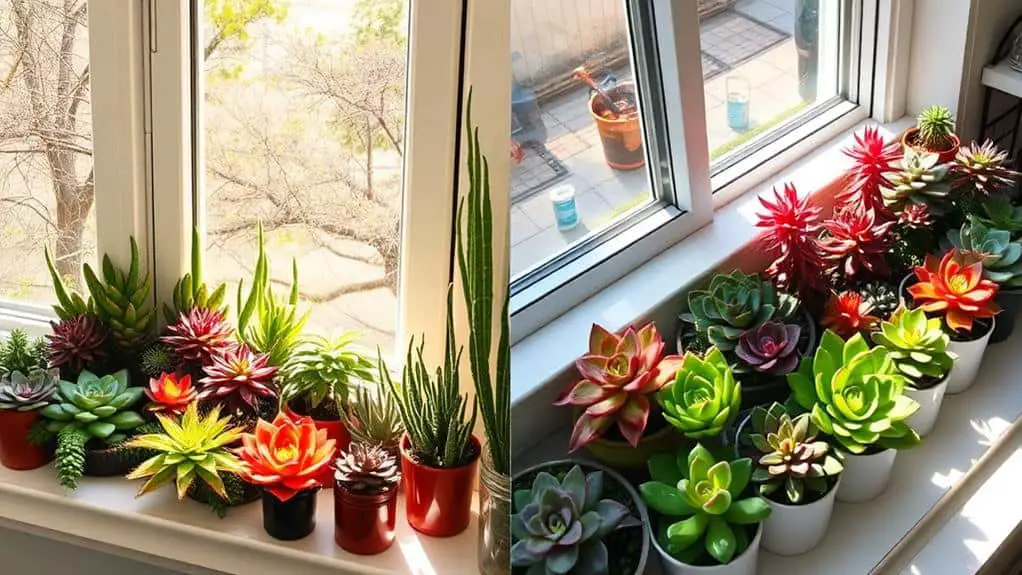
Adjusting your watering routine for succulents based on seasonal changes is crucial to guarantee their health and growth. Your succulents need specific care to keep thriving throughout the year.
In spring, when plants enter their active growing phase, water them every 7-10 days. Their soil dries out more quickly, so increasing the frequency for watering is important.
As summer heat kicks in, maintain regular watering intervals of 1-2 weeks, but monitor the soil closely. The higher evaporation rates mean you might need to adjust based on how fast the soil dries.
As fall approaches and temperatures drop, reduce watering gradually to every 4-6 weeks. Plants slow their growth, and soil retains moisture longer.
Track Your Watering Schedule
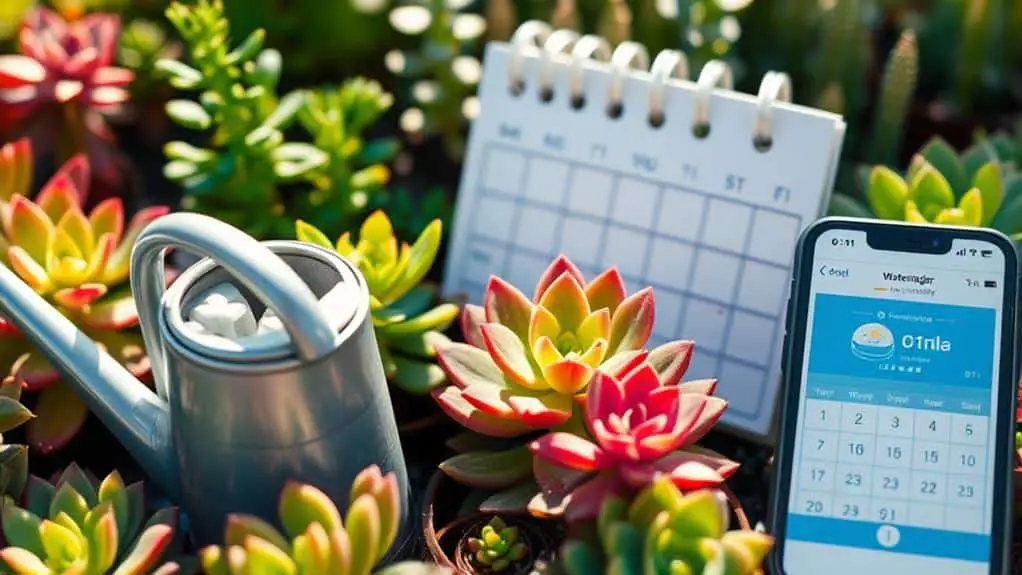
Keeping a record of your watering dates is vital for maintaining a consistent care routine and preventing the common pitfalls of over or under-watering your succulents. By tracking your watering schedule, you'll guarantee they get the water to thrive and stay healthy.
Here's how you can keep track of your watering:
- Use a Succulent Tracker app: Apps like the Succulent Tracker app help you monitor your watering history and set reminders.
- Create a cheat sheet: Make a quick reference guide with signs of over or under-watering to help maintain ideal moisture levels.
- Visual tracking: Keep an eye on your plants. Regularly check their growth and health to spot any issues early.
- Pen and paper or spreadsheets: Sometimes, traditional methods work best. Write down your watering dates in a notebook or spreadsheet.
Following these steps helps you avoid over or under-watering, which is vital for your succulents' health.
When in doubt, it's better to go without watering, as too much water can harm them more than too little. Regularly updating your watering records guarantees your succulents get the care they need, helping them to flourish.
Avoid Common Mistakes
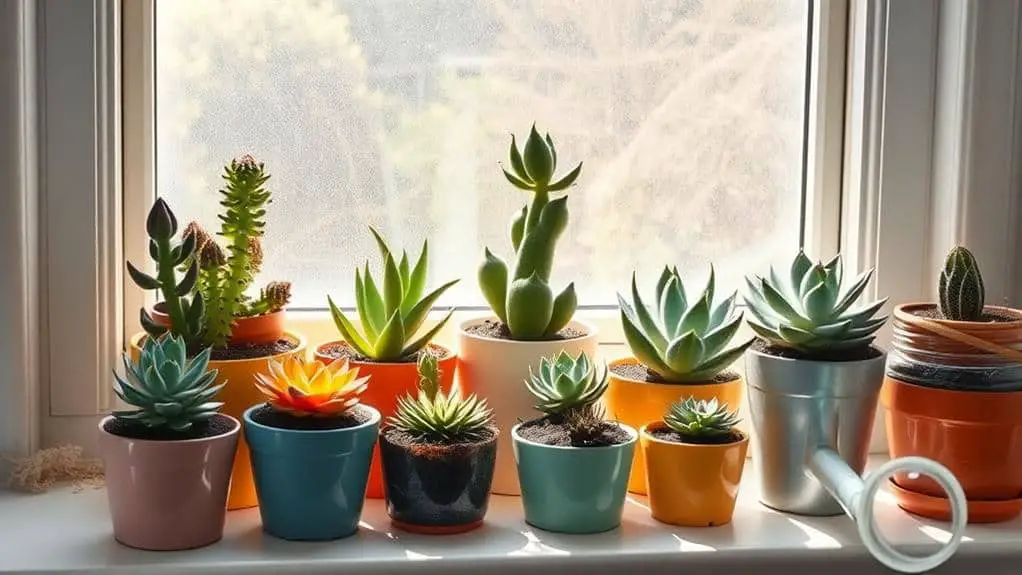
After you've established a reliable watering schedule, it's important to be aware of common mistakes that could undermine your efforts. Overwatering is the biggest culprit. Succulents thrive on less frequent watering; usually, every 14-21 days is sufficient, depending on environmental conditions. Always let the soil feel dry before watering again.
Make certain your pots have adequate drainage holes. Without proper drainage, waterlogged soil can suffocate the roots and cause root rot. A thriving succulent needs a well-draining mix; combine equal parts soil, sand, peat moss, and perlite to prevent water retention.
Pay attention to seasonal changes. Succulents need more water during their growth periods in spring and summer, but you'll want to reduce watering in fall and winter. This adjustment is essential to match their natural cycles.
Light exposure is another key factor. Placing succulents in low-light conditions can stunt their growth. Ensure they get enough light by gradually introducing them to direct sunlight to avoid sunburn.
Frequently Asked Questions
How to Water Succulents Properly?
To water succulents properly, use the soak and dry method. Soak the soil until water drains out, then let it dry completely. Check soil moisture regularly, adjust watering frequency based on conditions, and avoid cold weather watering.
How Do You Make Succulents Thrive?
To make succulents thrive, plant them in well-draining soil, water only when the top soil is dry, gradually increase sunlight exposure, fertilize in spring and summer, and use pots with drainage holes. Adapt care based on conditions.
Is It Better to Mist or Water Succulents?
It's better to water succulents deeply rather than mist them. Misting doesn't hydrate the roots well and can cause fungal issues. Deep watering guarantees the soil is soaked, promoting strong root growth and preventing rot.
How to Do Water Therapy for Succulents?
To perform water therapy for succulents, submerge only the root ball in water for 10-15 minutes. Avoid soaking the leaves. Afterward, let the plant drain completely before placing it back in its pot.
Conclusion
You've got this! By following these seven essential tips, you'll guarantee your succulents stay happy and healthy. Remember to check the soil, use the right watering methods, and choose well-draining soil and pots. Adjust your watering schedule with the seasons and keep track of your routine. Don't forget to watch for signs of stress in your plants. With a bit of attention and care, your succulents will thrive and bring joy to your space. Happy gardening!

